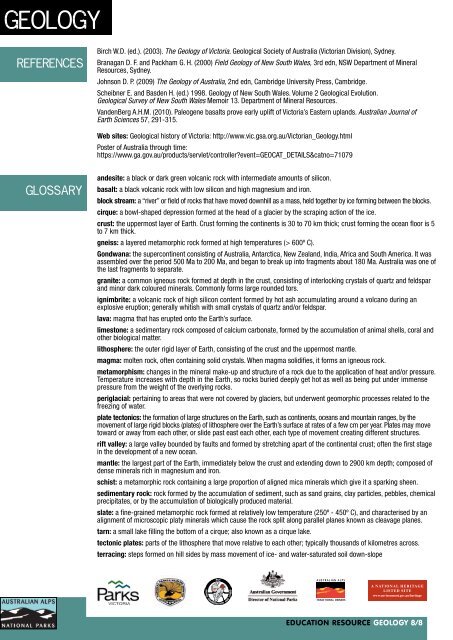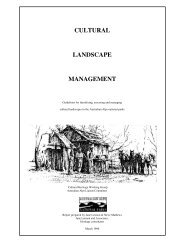Geology of the Australian Alps - Australian Alps National Parks
Geology of the Australian Alps - Australian Alps National Parks
Geology of the Australian Alps - Australian Alps National Parks
Create successful ePaper yourself
Turn your PDF publications into a flip-book with our unique Google optimized e-Paper software.
geology<br />
References<br />
Birch W.D. (ed.). (2003). The <strong>Geology</strong> <strong>of</strong> Victoria. Geological Society <strong>of</strong> Australia (Victorian Division), Sydney.<br />
Branagan D. F. and Packham G. H. (2000) Field <strong>Geology</strong> <strong>of</strong> New South Wales, 3rd edn, NSW Department <strong>of</strong> Mineral<br />
Resources, Sydney.<br />
Johnson D. P. (2009) The <strong>Geology</strong> <strong>of</strong> Australia, 2nd edn, Cambridge University Press, Cambridge.<br />
Scheibner E. and Basden H. (ed.) 1998. <strong>Geology</strong> <strong>of</strong> New South Wales. Volume 2 Geological Evolution.<br />
Geological Survey <strong>of</strong> New South Wales Memoir 13. Department <strong>of</strong> Mineral Resources.<br />
VandenBerg A.H.M. (2010). Paleogene basalts prove early uplift <strong>of</strong> Victoria’s Eastern uplands. <strong>Australian</strong> Journal <strong>of</strong><br />
Earth Sciences 57, 291-315.<br />
Web sites: Geological history <strong>of</strong> Victoria: http://www.vic.gsa.org.au/Victorian_<strong>Geology</strong>.html<br />
Poster <strong>of</strong> Australia through time:<br />
https://www.ga.gov.au/products/servlet/controller?event=GEOCAT_DETAILS&catno=71079<br />
Glossary<br />
andesite: a black or dark green volcanic rock with intermediate amounts <strong>of</strong> silicon.<br />
basalt: a black volcanic rock with low silicon and high magnesium and iron.<br />
block stream: a “river” or field <strong>of</strong> rocks that have moved downhill as a mass, held toge<strong>the</strong>r by ice forming between <strong>the</strong> blocks.<br />
cirque: a bowl-shaped depression formed at <strong>the</strong> head <strong>of</strong> a glacier by <strong>the</strong> scraping action <strong>of</strong> <strong>the</strong> ice.<br />
crust: <strong>the</strong> uppermost layer <strong>of</strong> Earth. Crust forming <strong>the</strong> continents is 30 to 70 km thick; crust forming <strong>the</strong> ocean floor is 5<br />
to 7 km thick.<br />
gneiss: a layered metamorphic rock formed at high temperatures (> 600º C).<br />
Gondwana: <strong>the</strong> supercontinent consisting <strong>of</strong> Australia, Antarctica, New Zealand, India, Africa and South America. It was<br />
assembled over <strong>the</strong> period 500 Ma to 200 Ma, and began to break up into fragments about 180 Ma. Australia was one <strong>of</strong><br />
<strong>the</strong> last fragments to separate.<br />
granite: a common igneous rock formed at depth in <strong>the</strong> crust, consisting <strong>of</strong> interlocking crystals <strong>of</strong> quartz and feldspar<br />
and minor dark coloured minerals. Commonly forms large rounded tors.<br />
ignimbrite: a volcanic rock <strong>of</strong> high silicon content formed by hot ash accumulating around a volcano during an<br />
explosive eruption; generally whitish with small crystals <strong>of</strong> quartz and/or feldspar.<br />
lava: magma that has erupted onto <strong>the</strong> Earth’s surface.<br />
limestone: a sedimentary rock composed <strong>of</strong> calcium carbonate, formed by <strong>the</strong> accumulation <strong>of</strong> animal shells, coral and<br />
o<strong>the</strong>r biological matter.<br />
lithosphere: <strong>the</strong> outer rigid layer <strong>of</strong> Earth, consisting <strong>of</strong> <strong>the</strong> crust and <strong>the</strong> uppermost mantle.<br />
magma: molten rock, <strong>of</strong>ten containing solid crystals. When magma solidifies, it forms an igneous rock.<br />
metamorphism: changes in <strong>the</strong> mineral make-up and structure <strong>of</strong> a rock due to <strong>the</strong> application <strong>of</strong> heat and/or pressure.<br />
Temperature increases with depth in <strong>the</strong> Earth, so rocks buried deeply get hot as well as being put under immense<br />
pressure from <strong>the</strong> weight <strong>of</strong> <strong>the</strong> overlying rocks.<br />
periglacial: pertaining to areas that were not covered by glaciers, but underwent geomorphic processes related to <strong>the</strong><br />
freezing <strong>of</strong> water.<br />
plate tectonics: <strong>the</strong> formation <strong>of</strong> large structures on <strong>the</strong> Earth, such as continents, oceans and mountain ranges, by <strong>the</strong><br />
movement <strong>of</strong> large rigid blocks (plates) <strong>of</strong> lithosphere over <strong>the</strong> Earth’s surface at rates <strong>of</strong> a few cm per year. Plates may move<br />
toward or away from each o<strong>the</strong>r, or slide past east each o<strong>the</strong>r, each type <strong>of</strong> movement creating different structures.<br />
rift valley: a large valley bounded by faults and formed by stretching apart <strong>of</strong> <strong>the</strong> continental crust; <strong>of</strong>ten <strong>the</strong> first stage<br />
in <strong>the</strong> development <strong>of</strong> a new ocean.<br />
mantle: <strong>the</strong> largest part <strong>of</strong> <strong>the</strong> Earth, immediately below <strong>the</strong> crust and extending down to 2900 km depth; composed <strong>of</strong><br />
dense minerals rich in magnesium and iron.<br />
schist: a metamorphic rock containing a large proportion <strong>of</strong> aligned mica minerals which give it a sparking sheen.<br />
sedimentary rock: rock formed by <strong>the</strong> accumulation <strong>of</strong> sediment, such as sand grains, clay particles, pebbles, chemical<br />
precipitates, or by <strong>the</strong> accumulation <strong>of</strong> biologically produced material.<br />
slate: a fine-grained metamorphic rock formed at relatively low temperature (250º - 450º C), and characterised by an<br />
alignment <strong>of</strong> microscopic platy minerals which cause <strong>the</strong> rock split along parallel planes known as cleavage planes.<br />
tarn: a small lake filling <strong>the</strong> bottom <strong>of</strong> a cirque; also known as a cirque lake.<br />
tectonic plates: parts <strong>of</strong> <strong>the</strong> lithosphere that move relative to each o<strong>the</strong>r; typically thousands <strong>of</strong> kilometres across.<br />
terracing: steps formed on hill sides by mass movement <strong>of</strong> ice- and water-saturated soil down-slope<br />
A U S T R A L I A N A L P S<br />
TRADITIONAL OWNERS<br />
A NATIONAL HERITAGE<br />
LISTED SITE<br />
www.environment.gov.au/heritage<br />
EDUCATION RESOURCE GEOLOGY 8/8

















